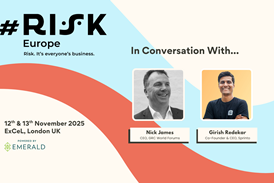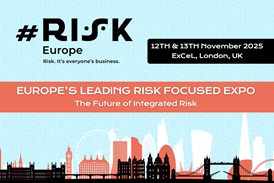Executive coach, strategic advisor and keynote speaker, Amii Barnard-Bahn was among experts speaking at Women in GRC last month.

The author of The PI Guidebook: How the Promotability Index® Can Help You Get Ahead in Your Career? (Edgewater Press, 2021), Amii gave viewers insight into how companies can strategise to retain and promote women employees.
Amii is a former Fortune Global 50 executive, an executive coach and consultant who specialises in accelerating the success of Fortune 500 executives and their teams. Amii shaped company culture and strategy for the past 20 years at global companies such as McKesson and Allianz in multiple roles (CAO, Chief Compliance Officer, and Chief Human Resources Officer).
Amii has been described by Forbes Magazine as “one of the top coaches for legal and compliance executives.” A contributor to Fast Company and Harvard Business Review, Amii is a member of Marshall Goldsmith’s 100 Coaches.
An expert in workplace culture, corporate governance and ethical leadership, Amii guest lectures at Stanford and UC Berkeley and presents frequently to associations such as the California Chamber of Commerce, Association of Corporate Counsel, How Women Lead, The Conference Board, Georgetown Alumni, and SHRM affiliates.
A lifelong diversity advocate, Amii testified in multiple committees on the successful passage of CA SB826 and WA SB6037, the first U.S. laws requiring corporate boards to include women.
Stephen White spoke with Amii following her talk to learn more about her experiences as an executive coach and to discuss hurdles to promotion that women employees face on the corporate landscape.
Could you take us through your career so far and how you became an executive coach and strategic advisor in this space?
I spent 20 years working in Fortune Global 50 companies, working my way up to executive roles, such as Chief Compliance Officer, Chief Administrative Officer and Chief Human Resource Officer, which gave me a pretty broad background.
Healthy workplace culture has always been important to me. It’s critical to build companies that are fair and equitable, and that are successful and achieve business objectives.
In my leadership roles, I often hired an executive coach to help me. I was the Chief Compliance Officer and built the first compliance and ethics programme at McKesson, US Pharmaceutical, a $90 billion business with a presence in 40 global locations, including Ireland.
At the time, I was new to healthcare, and that’s when I realised it would be valuable to have a coach and someone I could confide in to help me level up, because that was my first executive team experience. It can be challenging to shift from being at a director level where I had come from financial services.
I founded my leadership development and executive coaching consultancy around a mission to help organisations create healthy workplace cultures. I specialise in accelerating the careers of legal, risk and compliance executives and their teams, assisting with potential blind spots, and being more effective and influential with stakeholder relationships.
I have a passion for coaching what I call ‘gatekeeping functions’. These include HR as well as governance, risk and compliance leaders. They’re usually understaffed, the last ones thanked and the first ones blamed if something goes wrong.
Their task is, in my opinion, almost impossible because you’re expected to try to prevent every kind of legal and regulatory problem from occurring in the company, including reputation risks regarding business practices that the regulators and public may not have even considered yet as unethical or inappropriate.
I’ve been in situations where an industry practice might not be illegal, but people maybe should have questioned whether it was an acceptable business practice, and the situation has just crept up. So, it’s a tremendous task. Compared to other functions like sales, it can be difficult to attach data points to the significance of compliance work and to measure success in what you do, because you’re often trying to prove a negative.
I feel a particular kinship to supporting executives in these roles because I’ve been in their shoes. It’s a part of my mission in terms of building healthy workplace cultures.
Could you summarise the current business landscape for women employees and their pathways to promotion to senior roles?
Women are often underestimated. Studies show that men are promoted based on potential, whereas women are judged based on their past performance. Potential is subjective.
HR often uses a structure called a nine-box system for promotions, which ranks people based on two criteria: their past performance as well as potential. Yale University School of Management just released a study in retail that had similar findings to the survey that I mentioned earlier.
After analysing gender breakdowns at a large retail chain, the study found that although more than half of entry-level workers are women. They become harder to find as you look up the corporate ladder. Women are 14% less likely to be promoted, and managers are more likely to flag men as potential leaders.
Furthermore, men far outnumber women in high-potential programmes, and it’s generally because managers often see women as having lower leadership potential than male colleagues, even though women, according to the study, outperform men on average.
I’m curious about how some research has shown that women are given less performance feedback than men in terms of how to improve. So that could be a tangible area that we could work on and improve for equitable treatment.
Feedback is critical to leadership progression in terms of how you’re viewed. And what’s more, women do tend to be held to higher standards. One thing that’s important to point out is that women also rate other women lower on potential. So, the higher standard for women is held across both genders.
What are the key challenges that women face when it comes to earning promotion?
The first is visibility. In general, men have more access to power networks than women do. Women are working on this, but it’s still the case that men generally have more access. More men are CEOs, and are involved in high-level clubs and networks.
Now that more companies are remote, there’s a concern around what’s been termed “proximity bias” – the reality that people you see the most, and the ones that have the most access to you, are most likely to have a closer relationship with you. As a result, they are more likely to get the better projects – to have access to informal information that can be important strategically in terms of how you do your job.
I coach globally, and so many of my executives have teams that have been spread around the world. So, there’s always been a risk of not being at the home office. If you don’t want to be at the top, then that’s fine – many people don’t. But if you do, or if you want to get promoted to get a good assignment, you often need to find ways to be visible when you’re not physically there.
For companies that were accustomed to an in-person culture, remote work has made presenteeism a huge issue across the board. Leaders need to be very intentional about equalising access in remote work situations. We know that the pandemic (and the potential need for continued remote work) can disproportionately affect women. It’s a risk to men as well. But for women, the impact is greater because they’ve been shouldering more of the at-home burden — school closures and eldercare, visits to the doctor and like responsibilities.
My global clients had an annual strategy of making ‘round the world trips, and they would make sure that they went to all the big offices and had one-on-one meetings to connect with key stakeholders in addition to the virtual meetings.
Newly remote employees likewise need to have a visibility strategy to stay on the radar in a positive way. Ideally, leaders and women will work together to reduce the risk of proximity bias in promotions, work assignments, and other perks.
What can what can leaders do to create an environment that offers women more support and more opportunity to win promotion?
Providing coaching, honest feedback and sponsorship are critical; support of that nature is really important for women to get ahead. It’s also important to have a sponsor who can speak for you when you’re not in the room, particularly concerning promotions or assignments – it’s absolutely fundamental to getting promoted. Sponsors are willing to vouch their reputation on you.
Men in general act as sponsors more than women do, because generally they have more power in an organisation. So, I would encourage men to look for a talented woman to mentor. Male allies are critical. My career progressed due to both men and women sponsors; they’re critical to career progression, promotion, and getting to the C-suite.
What inspired you to write “The PI Guidebook: How the Promotability Index® Can Help You Get Ahead in Your Career?”
About a year and a half ago, I had created the free Promotability Index® (PI) assessment. The PI is an 82-question, leadership self-assessment that helps people discover how they are currently perceived in terms of the five key elements organisations use when determining who to invest in and promote. These elements are: self-awareness, external awareness, strategic thinking, executive presence, and thought leadership.
The PI helps you assess your unique strengths and opportunities on each element, and identify what you might want to work on improving. I wanted to make a tool available to people who perhaps didn’t have a sponsor or didn’t have a coach. Professionals who are ambitious and hardworking, and want to learn how to get ahead. Being a successful leader is more than just mastering your technical skills.
I recently wrote an article in Harvard Business Review on this – explaining how relationships become more important at a certain point in your career. People, especially technical specialists, over-index on their subject matter knowledge and underinvest in their relationships. Many of our GRC colleagues are the lawyers or the auditors or risk professionals of that nature, and they spend half their lives getting exceptional credentials and learning their field.
But at a certain point in everyone’s career, technical skills become just the ticket to the game. And then relationship-building and influencing skills become more important for you to get that seat at the table, either at the C-suite level or on a corporate board. The Promotability Index Guidebook grew out of the assessment. My clients and thousands of other professionals took the PI assessment, they loved it, they found it quite helpful, and then they asked for more help in improving these areas.
Again, not everyone has the resources to hire a coach. So, I wrote the companion Guidebook that has over 30 exercises that you can pick from depending on how you did on the PI assessment. For example, you can specifically choose to work on executive presence, and select corresponding exercises to improve.
Organisations have also been using and adopted the PI as part of their annual performance review process; I have a case-study on my website on it. The PI creates a shared language around objective criteria for promotions. Much of what we’ve been talking about regarding equity concerns the importance of having objective criteria, and reducing subjectivity as much as possible for getting ahead. That’s one of the number one ways that organisations can help reduce inherent bias in promotions for people of colour, for women, for people with disabilities, and other underrepresented groups of talent.
One great exercise I encourage people to do is take the assessment, then share the results with their boss. Ask them where they do and don’t agree with the self-assessment. This then leads to a feedback-rich conversation, which is really the essence of the process.
It offers the chance to unearth, reset, and create intentional leadership behaviours that develop true potential. If people get the performance feedback they need, if organisations adopt more objective criteria, if they’re conscious about who gets promoted and why, then we will have the best leaders leading.
Can you sum up how your book can help professionals to get the edge over the competition?
One of the healthiest things you can do for your career is to focus on what you can control. And over the last couple of years, that’s been challenging for people because a lot of things have been out of our control. And it’s been hard for organisations to know how to keep culture and community and create a feeling that they care about and want to invest in their employees.
What I think people appreciate about the Promotability Index, is that it puts control back in their hands around what they can do to continue to improve their marketability. It is customisable to what you’re interested in working on, a sort of choose-you-own-adventure in terms of where you want to improve, depending on what levels you are at in your career. Forbes called it “a SWOT analysis for your career.”
The PI divides the reader into three categories, in terms of discovering, advancing and establishing yourself in your career. Combined with the book, readers get a powerful set of tools that will enable the right kinds of conversations, or enable them to work on their own should they not have a sponsor or assistance from within their organisation.
To end, I’d like to quote Peter Drucker, who said:
“You should not change yourself, but create yourself. That means build around your strengths and removing bad habits.”
I love those words because that’s really what coaching and personal growth are all about. It’s about identifying your strengths and working on your derailing behaviours. What might be holding you back? Where can you improve and where can you keep growing? The book is designed to be a lifelong companion that you can revisit as and when needed. I have people who keep returning to it and they’re enjoying seeing the progress they’ve made.
Click here to hear Amii Barnard-bahn talking at Women in GRC World Forum.















No comments yet